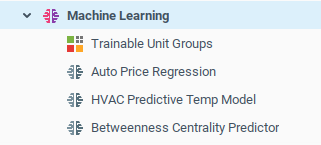Machine Learning
Machine Learning module allow managing and operating trainable units that leverage various supervised learning algorithms to analyze machine data, classify time series, make trend predictions and discover anomalies.
Once other Iotellect data processing tools cooperate for advanced dataset preparation, trainable unit are the key to solving practical tasks, such as predictive maintenance, enhanced operational efficiency, improved quality control, threat detection, or customer experience personalization.
Machine Learning tasks are usually categorized into two main categories: supervised learning and unsupervised learning:
Supervised learning requires a labeled set of data that is used to train a machine learning model. A label is a value of the target variable (a variable that is assumed to be dependent on one or more independent variables, also called features or attributes) that is taken by the model as the ground truth.
Unsupervised learning does not require labeled data and is used to learn structure from input data.
The Iotellect Machine Learning module is designed to solve the three main types of supervised machine learning problems: regression, classification, and anomaly detection.
Regression
Regression is a machine learning task of predicting an output that is a real number.
A typical example of a regression problem is the prediction of the price of a house based on several attributes such as the living space, the number of bedrooms, the number of storeys, the city area, and so on.
Classification
In classification, the output values are divided into two or more classes. The task is to assign new inputs to one or more of these classes.
An example of a classification problem is the problem of detecting whether or not an image contains text (this would be a binary classification problem), or the problem of optical character recognition (this would be a multiclass classification problem).
Anomaly detection
Anomaly detection can be approached as one-class classification. The machine learning model is trained on a dataset containing only non-anomalous data and then is used for predicting whether or not a new data instance is anomalous. One-class classification is sometimes deemed as an unsupervised machine learning task, as the labels in the training set are all the same ("normal") and hence, in a way, become unnecessary.
Trainable Unit
A child of the Machine Learning context is called a Trainable Unit. A Trainable Unit provides functions and actions necessary for building and evaluating a machine learning model.
 | Every user has their own set of trainable units. |
Administering Trainable Units
Two contexts are used to administer trainable units: One is the general Machine Learning context, which serves as a container. The other is the Trainable Unit context, which holds the information for a single trainable unit. |  |
Was this page helpful?